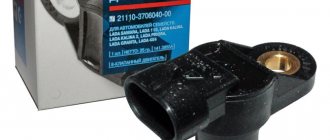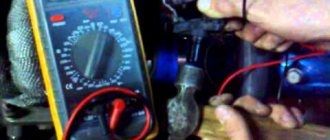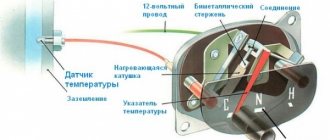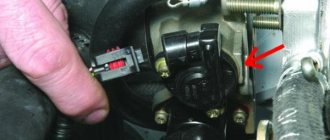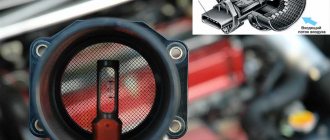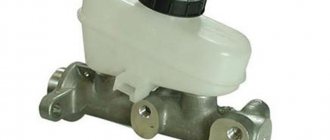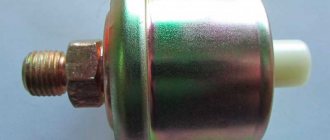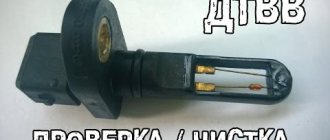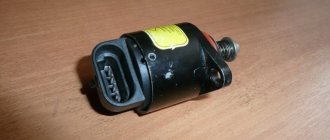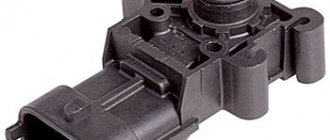Problems in the operation of the DPRV can seriously threaten the safety of the driver and passengers. Imagine the situation: you are driving in heavy traffic in a large city, and suddenly the engine suddenly loses power, which leads to a significant decrease in the speed of your car. Very often it ends in an accident, because the driver driving behind simply does not have time to react.
Another option is that while driving, the engine stalls and the power steering is turned off, which is why you cannot make a sharp turn. The situation is sad and this really happens. In other situations, you simply leave the house to go to work, and the engine does not start at all.
This article will discuss the main symptoms of a DPRV malfunction. You will also learn where the camshaft sensor is located and how to check it yourself. But first, let's try to figure out why it is needed at all.
What is camshaft position sensor (camshaft position sensor)?
The cylinder head of the power unit contains 1-2 camshafts. They are equipped with special blades responsible for controlling the intake and exhaust valves. The block also contains a crankshaft, which drives the camshaft through gears, a timing belt, or a timing chain.
To determine the working cylinder, the engine ECU analyzes the rotating position of the camshaft in relation to the current position of the crankshaft. This is exactly the information that the DPRV reports. The control unit uses the received data to correct the operation of the fuel injectors and spark formation. This means that fuel economy, engine efficiency and the level of harmful emissions depend on the performance of the camshaft sensor.
Today, cars are equipped with two types of DPRVs - electromagnetic (inductive) and Hall sensors. Sensors are used to transmit a signal to the engine control unit.
The inductive sensor produces an AC signal and is easily identified by its two wires.
But the Hall sensor needs additional power to create a signal, so another wire goes to it (three in total). Important! The camshaft position sensor functions in harmony with the crankshaft position sensor.
Working principle of the camshaft position sensor
There are three types of DPRV:
- Magnetic (inductive type) . The principle of operation is based on the passage of a metal object (tooth) in a constant magnetic field. Magnetic sensors usually have two terminals.
- Based on the Hall effect . Records changes in the magnetic field around the sensor. Such sensors usually have three terminals.
- Optical . The principle of operation is based on recording the reception and interruption by a photocell of a beam of light emitted by a source.
The most common DPRVs are of the first two types. Optical ones are used only in some brands of cars (for example, cars based on the Mazda GE platform). Some car models may have two or more sensors installed. And perhaps of different types.
Integral sensor
Hall effect sensor
Optical sensor circuit
A rotor made of ferromagnetic material rotates together with the camshaft. The Hall IC is located between the rotor and the permanent magnet, which produces a magnetic field vertical to the Hall element. When a tooth passes the sensor's sensing element, the magnetic field strength changes. Due to this, a voltage is induced and a digital signal appears in the Hall IC. Thus, rotation of the camshaft pulse sensor gear changes the Hall voltage in the Hall IC at the sensor head. The changing voltage is transmitted to the control unit and analyzed.
Operating diagrams of various sensors
The sensor is integral, that is, it includes a sensing element and a secondary signal converter. The main function of the sensor is to record the cylindrical phases of intake and exhaust. That is why it has a second name - phase sensor.
Problems that a faulty camshaft sensor can create
Malfunctions of the DPRV can lead to various problems. It all depends on the specific car and the breakdown of the sensor itself. Most often, motorists mention the following symptoms of a malfunctioning camshaft sensor:
- Transmission locking at one speed. To remove the blockage, you have to turn off and start the engine again. The phenomenon can appear at certain intervals.
- Significant reduction in engine power. For example, it is often impossible to accelerate a car above 55-60 km/h.
- The engine may suddenly stall.
- If DPRV malfunctions begin while driving, the car may jerk, and engine power drops noticeably.
- Misfire, difficult starting or engine choke, poor dynamics.
- Sometimes a failed camshaft position sensor simply blocks the formation of a spark, so the car cannot be started at all.
Neokey › Blog › Symptoms of a faulty camshaft sensor
The condition of your car is monitored by “smart” sensor devices, the signals from which are sent to the control computer as the car moves.
One of them is the camshaft position sensor (CPS), a device that is extremely necessary for stable control. DPRV - main functions
Signs of a faulty camshaft sensor may vary. The device itself, as is clear from the name, monitors the stability of the engine, the position of the cam shaft at certain points in time, the distribution of the fuel mixture entering the cylinders, and exhaust. That is, on the work of the entire motor as a whole. And the information received by the computer is important for both ignition and startup. Without this, a modern car will not move or start.
Operating principle
DPRV has a fairly simple device. It is made of a magnet that is connected to a recognition system. By closing a tooth on the cam (camshaft) shaft, the device transmits a signal-pulse to the car's computer. And he, in turn, is constantly aware of the position of the piston. This allows you to accurately inject fuel, form an air-fuel mixture and ignite it at the required moment when starting the engine.
Symptoms of a faulty camshaft sensor
— On some vehicles, if the camshaft position sensor is faulty, the transmission may lock up in one gear until you turn off the engine and start it again. This can be repeated with a certain cyclicity.
— If the camshaft sensor begins to work incorrectly while the car is moving, you may feel that the car begins to move jerkily, losing speed.
- If the camshaft sensor fails, you may experience a noticeable loss of engine power. For example, your car will not be able to accelerate above 60 km/h.
— The engine may stall intermittently due to a faulty CMR sensor
— If the sensor fails, you will notice poor engine performance: loss of dynamism, misfires when turning on the ignition, jolts during acceleration, popping noises in the exhaust system, etc.
— On some car models, if the camshaft sensor is faulty, the ignition spark may completely disappear, which will ultimately lead to failure to start the engine
How to check the sensor yourself?
Of course, in order to make the most effective repair or replacement of the DPRV, it is necessary to use the services of a specialist at a service station. The device can be verified in accordance with the standards using an oscilloscope. But sometimes it happens that it is not possible to use the service at the moment. With a regular voltmeter and some skill, you can check the device or replace it. Of course, it is quite difficult to achieve precise accuracy of testing at home, but it is quite possible to do something real. We check the presence of current throughout the entire electrical circuit of the car, in the wires leading directly to the sensor. To do this, turn on the ignition by closing the circuit, having previously removed the wires from the DPRV. If there is no voltage in the wires, then the reason is in them (perhaps the contact is lost somewhere). If you see signs of a malfunction of the camshaft sensor in the presence of current in the circuit and wires leading to the device, then we continue checking as follows: we attach one of the voltmeter contacts to the signal contact of the device, and we close the other to power. And if the voltmeter does not show any changes when the starter rotates, then it means that the DPRV itself is “to blame”, and it needs to be replaced (if you have a new one, you can also do this yourself).
Source
What leads to malfunctions of the DPRV
Like any element of the car, the camshaft sensor at some point stops working. For example, this occurs as a result of wear on the internal part or wire. Depending on the type of sensor used, engine operating problems vary. As soon as the “brains” of the car detect a malfunction in the operation of the DPRV, the Check Engine icon will light up on the instrument panel, and a diagnostic fault code will be stored in the memory of the control unit. This will make it easier to find the problem in the future.
Meter design and location
The operating principle of the DPRV is based on the Hall effect - the sensor reacts to the approach of a metal mass by changing the voltage on the signal wire. The design of the device is similar to another element - the crankshaft position detector. Inside the plastic case there is a coil where the 12 V on-board voltage is constantly supplied.
The meter is installed on the engine cylinder head in close proximity to the camshaft. The latter is equipped with a special plate or gear, whose rotation affects the DPRV. The work algorithm looks like this:
- After turning on the ignition and starting the engine, a supply voltage of 12 V is supplied to the sensor. Through the third signal wire, the element supplies the controller with a voltage of 90–95% of the original one.
- When the protrusion on the rotating part of the camshaft passes next to the DPRV housing, the voltage at the signal contact drops to 0.2–0.4 volts, depending on the design of the device and the vehicle model.
- When the voltage drops, the electronic unit clearly “sees” the valve timing, promptly supplies the fuel mixture to the engine cylinders and directs the spark discharge to the desired spark plug.
Note. On cars with 16-valve engines, 2 sensors are installed - one for each camshaft.
When the meter is faulty, the electronics are unable to control the operation of the gas distribution mechanism. In such cases, the control unit goes into error and is guided by the signals of other meters. Spark generation and fuel supply are adjusted according to the programmed program, which affects the operation of the power unit.
Location of the DPRV
The location of the camshaft position sensor varies depending on the specific engine. As a rule, it is located somewhere in the cylinder head area. It is necessary to inspect the upper part of the timing chain or belt, or pay attention to the rear of the cylinder head. Some DPRVs are in special compartments. Sometimes a car's power unit may be equipped with not one, but several sensors.
If a visual inspection does not bring any results, we advise you to study the operating instructions for your car. If you don't have a printed publication at hand, look up information about the location of the camshaft sensor on the Internet.
Troubleshooting Camshaft Sensor (CMP)
If your car’s computer has detected a sensor error and turned on the “Check Engine” icon on the dashboard, then you can easily find out the “error code” yourself, which led to the appearance of the light indication on the dashboard. To do this, we advise each driver to purchase an inexpensive set of diagnostic equipment specifically for computer diagnostics. If you cannot afford to purchase this diagnostic scanner for your car, then contact any inexpensive car service center to diagnose your car, where they will read the “error code” from your car’s computer.
Once you know from the "error code" that your car has a faulty camshaft sensor or related components, you should do a few simple tests. Please remember, friends, that a fault “code” indicating a potential failure of the camshaft position sensor will not necessarily mean that the CMP sensor itself has failed on the car. After all, it is possible that the cause of the malfunction is not in the sensor itself, but in the sensor connector, or there is damage to the wires connected to it, or perhaps the components directly connected to it have failed.
True, you need to remember the following for yourself, in order to more accurately determine whether the camshaft sensor is functioning normally, you will need to carry out (possibly) quite a lot of diagnostics. It is especially necessary to take into account the following in order to check the effectiveness of the CMR sensor signal itself; in some cases, this may require special equipment, without which it will be difficult to determine the cause of the malfunction.
However, you can do a few simple checks yourself using a digital multimeter (DMM).
First, check the electrical connector at the camshaft sensor and the condition of the wires themselves. Disconnect the connector itself and check for signs of rust or dirt. For example, the same fuel. All this can interfere with good contact for the transmission of electricity.
Next, check for damage to the wires, namely, whether the wires are torn or showing signs of melting from nearby hot surfaces.
In addition, please make sure that the camshaft sensor wires do not touch the spark plugs or ignition coils, which could cause interference and prevent the sensor from transmitting the correct signal.
After the above checks, use a digital multimeter that can test alternating current (AC) voltage or direct current (DC), depending on the specific type of camshaft sensor used in your vehicle.
Also, before testing, you need to set the correct electrical parameters on the multimeter for a specific type of CPM sensor. Typically, such information is indicated in the vehicle repair and maintenance manual.
Some camshaft sensors allow you to create a splitter for the electrical circuit of the CMR sensor; this is done primarily in order to read the signal directly from the sensor itself during its operation in the car.
If the type of your sensor does not allow you to connect the multimeter wires to it, then you can simply disconnect the connector from the sensor and attach a copper wire to it, thus inserting it into each sensor connector.
You can then connect this connector back to the sensor, being careful not to short the wires themselves during testing. If you use (apply) this method, do not forget to first insulate the wires with electrical tape.
Testing a 2-Wire Camshaft Sensor
Three-wire camshaft sensor testing
If, after self-diagnosis of the camshaft position sensor, you determine that it is fully operational, then there may be a breakdown or malfunction in the vehicle components associated with this sensor.
Troubleshooting DPRV
If the Check Engine indicator on the panel has already come on (it may not be lit constantly, but may appear periodically), you just need to read the fault code using a diagnostic device. If you do not have such a device and it is impossible to buy it, you need to contact a specialist.
After receiving the exact fault code and decoding it, we recommend performing several simple tests. The presence of one of the above DPRV fault codes does not always indicate that the sensor must be replaced. Sometimes the source of the problem is damage to the wiring, connector, etc. It is quite possible to fix such problems on your own.
But to check the functionality of the camshaft position sensor itself, you need to perform several steps. Of course, it is difficult to check the signal without special equipment. But checking the camshaft sensor with a multimeter will provide basic information.
First, visually check the condition of the sensor connector and the wires that go to it. Make sure there is no dirt, oil or rust that could cause problems. Check the wires for damage. Sometimes problems are caused by broken wires, poor connections, or defects in the insulating layer caused by exposure to elevated temperatures. The DPRV wires should not come into contact with the high-voltage wires of the ignition system.
After that, we pick up a digital multimeter; it “knows how” to check the value of alternating and direct current (AC and DC, respectively). But you need to obtain information in advance about what these indicators should be for the sensor used on your car.
Some sensors have connectors designed so that you can connect additional wires to them to read data with a multimeter.
If this is not possible, try disconnecting the DPRV connector and connecting thin copper wires to each terminal of the connector. After this, install the connector in place so that two wires protrude from its body.
Another option is to pierce each of the wires with a needle or pin (do everything carefully so as not to short the wires!). After such a diagnosis, damaged areas of insulation should be well wrapped with electrical tape to prevent moisture from getting inside.
Checking the two-wire camshaft position sensor:
- If your car uses an electromagnetic DPRV, switch the multimeter to AC mode.
- Another person must turn the ignition on by turning the key in the lock without starting the engine.
- Voltage should appear in the circuit. Connect one of the multimeter probes to ground (any metal component of the engine), and connect the second one in turn to the camshaft sensor wires. The absence of current on all wires indicates a problem in the wiring that goes to the sensor.
- Ask the person in the car to start the engine.
- Touch one multimeter probe to one wire of the DPRV connector, and the other to the other. Values will appear on the device screen, which should be compared with the operating readings given in the car’s operating instructions. As a rule, the readings on the screen vary within 0.3-1 volts.
- The absence of a signal indicates a malfunction of the camshaft sensor.
Checking a three-wire DPRV:
- Identify the power, ground and signal wires (use the repair instructions), and then check the integrity of the wiring that goes to the sensor. The multimeter must be switched to DC mode.
- Another person must turn on the ignition without starting the engine.
- We connect the black probe of the multimeter to “ground” (any metal part of the engine), and the red probe to the power supply wire of the DPRV. The results obtained should be compared with the data in the operating instructions.
- An assistant must start the engine.
- Touch the red probe of the multimeter to the signal wire of the DPRV, and connect the black probe to the ground wire. If the sensor malfunctions, the voltage will be lower than stated in the repair manual. Sometimes the multimeter does not show anything at all, which also indicates a sensor failure.
- Remove the DPRV and check the element for mechanical damage or contamination.
Below is a video that clearly demonstrates how you can conduct such tests. In some cases, the electrical circuit is working properly, and the sensor also gives correct readings during tests. The question arises: why do errors and problems appear in engine operation? Sometimes the causes are related to other engine components. Errors may appear due to a loose timing belt or a faulty tensioner. Because of this, the DPRV will transmit the wrong signal.
Camshaft Position Sensor Testing
How to check the camshaft position sensor
Testing an inductive DPVR and a sensor based on the Hall effect are similar. In the process, the voltage value between their terminals is measured. To do this, you will need a multimeter that can measure DC voltage. Checking the operation of the sensor should begin with the following procedures:
DPRV with three terminals
- Check the connection of the sensor to the signal wiring harness. It should be connected to +12 V and ground (see figure).
- If there is power and ground to the sensor, then you need to start the engine and check for the presence of pulses on the signal wire.
- Check for moisture in the connector. To do this, you need to disconnect the plug with signal wires from the sensor and check the dryness of the plug and socket itself. If there is oxidation or contamination, clean and dry.
- Check the insulation of the signal wires. Statistically, its damage is the most common cause of malfunction. The fact is that the sensor is located in close proximity to the engine. Therefore, the insulation heats up and over time breaks and crumbles, leading to a short circuit.
- Check the inductive sensor's insulation resistance value. As a rule, it is about 0.5...1 kOhm. For some sensors it will be several kOhms (check the manual for your car for detailed information). The main thing is that the insulation is not broken.
Scheme for checking DPRV
check the operation of a sensor based on the Hall effect in the following way. To do this, assemble the circuit shown in the figure. In the diagram: 1 - sensor body, 2 - plug block, 3 - resistor with a resistance value of 0.5...0.6 kOhm, 4 - AL307 LED, 5 - metal object (for example, a screwdriver). A car battery is used as a power source. To check, you need to move a metal object near the sensor. If it is working properly, the LED should light up briefly. If this does not happen, it means the sensor is faulty.
There is another way to test a sensor based on the Hall effect . We disconnect the sensor from the connector, and connect a multimeter to its terminals in DC voltage measurement mode. Turn on the ignition. The voltage value between the “ground” of the sensor and the general “ground” should be 0 V. And the voltage between the common “ground” and the power contact of the sensor should be within 10...12 V. A metal object must be moved near the body. If the values on the multimeter change, the sensor is working. Otherwise, no.
Checking a two-wire (inductive) sensor
If your machine has a two-wire DPRV (inductive type), then it must be checked in the following sequence:
- Set your multimeter to AC voltage function.
- Turn the ignition key without starting the engine.
- Check for voltage in the circuit. To do this, connect one contact of the multimeter to ground, and with the other, check each wire in the DPRV connector. If there is no voltage on any of them, the sensor is completely faulty.
Another way is this:
- Start the car engine.
- Connect one contact of the multimeter to one wire of the sensor, the second contact to the other. If the sensor is working properly, then you will see a fluctuating voltage on the tester in the range of 0...5 V (check the exact value in the manual of your car). If there is no voltage, the sensor is faulty.
Checking three-wire DPRV
Testing a sensor based on the Hall effect is carried out according to the following algorithm:
- Set the multimeter to DC voltage measurement mode.
- Turn the key in the ignition, but without starting the engine.
- Connect one contact of the device to ground. The other contact is to the sensor power wire. Compare the voltage obtained with that indicated in the manual for your car.
Another way:
- Start the engine.
- Connect one contact of the multimeter to the black wire of the sensor, the second contact to the red (power wires). The resulting voltage value must match that specified in the machine manual. If there is no electricity at the contacts, the sensor has failed.
Typically, the camshaft position sensor cannot be repaired. Therefore, if it fails, you need to buy a new one. Its price is about $4...10 depending on the brand of sensor and car.
Cost and replacement of the camshaft sensor
If the test results finally convince you that the DPRV is faulty, it must be replaced. On many cars, changing the sensor is very simple. It all comes down to disconnecting the electrical connector, unscrewing just one mounting bolt, removing the old one and installing a new sensor. On other cars, you have to remove several engine components at the same time, otherwise you will not be able to gain access to the sensor. To assess the possibility of replacing the DPRV yourself, we advise you to study the corresponding paragraph in the repair manual for a specific car. The cost of a camshaft sensor usually ranges from $30-$100.
Symptoms of a faulty camshaft sensor
Just like any part or component in your vehicle, this CMP sensor will eventually, sooner or later, simply stop working due to wear and tear. This happens anyway once its maximum service life has expired. This usually occurs due to wear on the internal wire wrap or a component associated with it.
Usually, in this case, the engine in the car begins to work intermittently, and the signs of a malfunction can vary in different ways, i.e. depending on the type of sensor wear. For example, the same connector in a sensor may wear out, the same internal circuitry in the sensor may fail, or a component associated with the sensor may fail.
Results
At the beginning of the article, we mentioned the unpleasant consequences that can result from a breakdown of the DPRV. If you find at least one of the signs of a malfunction of the camshaft position sensor, we advise you to diagnose the problem as quickly as possible. Otherwise, you might just end up standing in the middle of the road. Start by reading the fault codes stored in the ECU memory and, if necessary, check the sensor itself. Now you already know how to do this using a regular digital multimeter. Very often you can solve the problem yourself without spending extra money on diagnostics and replacement.
Characteristic symptoms of the problem
Practice shows that a malfunction of the camshaft position sensor does not lead to engine failure and immobilization of the vehicle. The engine continues to operate with some deviations that interfere with the normal operation of the car. Symptoms of DPRV failure are quite vague and similar to problems with other measuring elements:
If the measuring element is faulty, the control unit prepares and supplies an enriched air-fuel mixture to the cylinders. This results in an increase in gasoline consumption and unstable idling. Jerks and drops in power are caused by untimely supply of a spark - the controller “does not see” the end of the compression stroke in the cylinder and cannot clearly determine the ignition timing.
On various car models, additional symptoms of a malfunctioning camshaft sensor are noted:
Reference. The service life of the element is quite long. On domestically produced cars, the resource reaches 80–100 thousand km, on imported cars – 150 thousand km. When searching for the causes of a malfunction, you can focus on the specified periods.
Driving with a broken air pressure sensor is acceptable for a short period. Jerking, rich fuel mixture and electronic errors accelerate the wear of spark plugs and engine parts. After detecting the listed symptoms, you should send the car for diagnostics or find the source of the problem yourself.
Repair and replacement of DPRV
Actually, there is no need to talk about repairing the camshaft sensor; all repairs here come down to checking the sensor connection and eliminating breaks in the electrical circuit. If the sensor fails, it only needs to be replaced. Repair of such devices is not provided for by their design itself. Meanwhile, there are special error codes that allow you to determine the breakdown of this particular sensor, as well as understand the nature of the problem.
Changing the camshaft position sensor must take into account whether it fits your car model or not. This device, alas, like most automotive electronics, is by no means universal. Therefore, when purchasing a new sensor, check whether it will fit your car. Better yet, entrust this matter to a professional. The electronic components of modern cars are very sensitive, capricious and, most unpleasantly, expensive. Therefore, replacing and configuring on-board electronics should be done by truly experienced specialists.
What is a phase sensor used for?
To understand possible malfunctions of the phase sensor, it makes sense to briefly dwell on the question of what it is, as well as the principle of its design.
Thus, the main function of the phase sensor (or DF for short) is to determine the position of the gas distribution mechanism at a specific point in time. In turn, this is necessary so that the electronic engine control unit (ECU) gives the command to inject fuel at a certain point in time. In particular, the phase sensor determines the position of the first cylinder. The ignition is also synchronized. The phase sensor works in conjunction with the crankshaft position sensor.
Phase sensors are used on engines with distributed phased injection. They are also used on engines that use a variable valve timing system. In this case, separate sensors are often used for the camshafts that control the intake and exhaust valves.
The operation of modern phase sensors is based on the use of a physical phenomenon known as the Hall effect. It lies in the fact that in a semiconductor wafer through which an electric current flows, when it moves in a magnetic field, a potential difference (voltage) arises. A permanent magnet is placed in the sensor body. In practice, this is implemented in the form of a rectangular plate of semiconductor material, to the four sides of which contacts are connected - two input and two output. Voltage is applied to the first, and a signal is removed from the second. All this happens on the basis of commands coming from the electronic control unit at a specific point in time
Signs of a faulty phase sensor
If the phase sensor fails completely or partially, the electronic control unit forcibly switches the engine to paraphase fuel injection mode. This means that the timing of fuel injection is carried out according to the readings of the crankshaft sensor. As a result, each fuel injector injects fuel twice as often. This ensures that a fuel-air mixture is formed in each cylinder. However, it is not formed at the most optimal moment, which leads to a drop in engine power, as well as excessive fuel consumption (albeit small, although this depends on the specific engine model).
Symptoms of a faulty phase sensor are:
In addition to the above symptoms, often when the phase sensor fails, problems arise with the vehicle’s self-diagnosis system. In particular, at the moment of starting, the driver is forced to turn the starter for a little more time than usual (usually 6.10 seconds, depending on the model of the car and the engine installed on it). And at this time, self-diagnosis of the electronic control unit occurs, which leads to the formation of corresponding errors and transfer of the engine to emergency operation mode.
Malfunctions of the phase sensor on a car with HBO
It is noted that when the engine is running on gasoline or diesel fuel, the unpleasant symptoms described above do not appear so acutely, which is why many motorists often use cars with a faulty phase sensor for a long time. However, if your car is equipped with gas equipment from the fourth generation and higher (which uses its own “smart” electronics), then the engine will work intermittently, and the driving comfort of the car will sharply decrease.
In particular, fuel consumption will increase significantly, the air-fuel mixture may be lean or, conversely, enriched, and engine power and dynamics will significantly decrease. All this happens due to a mismatch between the software of the electronic engine control unit and the LPG control unit. Accordingly, when using gas-cylinder equipment, the phase sensor must be changed immediately after its breakdown is detected. Using a machine with a damaged camshaft position sensor is harmful in this case not only to the engine, but also directly to the gas equipment and its control system.
